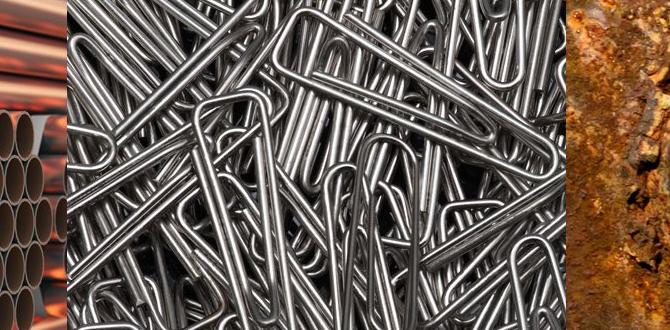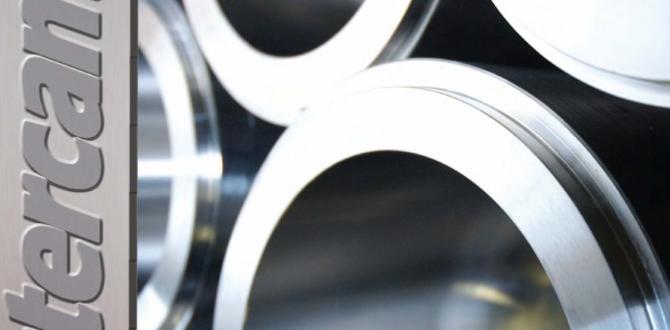Carbide end mills are the smart choice for cutting HRC60 hardened steel, offering superior hardness and heat resistance to tackle tough materials efficiently and with less tool wear.
When you’re working with tough materials like HRC60 hardened steel, choosing the right cutting tool can make all the difference. It can be frustrating when your tools wear out quickly or struggle to make good cuts. This is a common challenge for many home machinists and workshop enthusiasts. But don’t worry, there’s a fantastic solution that makes working with these hard steels much easier and more efficient. We’re going to explore a specific type of cutting tool that’s often overlooked by beginners but is a total game-changer.
This guide will walk you through exactly why this tool is so effective and how you can use it to achieve great results, even on the hardest metals. Get ready to discover a smarter way to machine hardened steel!
What Exactly is HRC60 Hardened Steel?
Before we dive into the solution, let’s quickly understand what we’re dealing with. “HRC60” refers to the Rockwell Hardness scale, specifically a reading of 60. This is a very high level of hardness for steel. Think of it this way: regular mild steel might be around HRC20, and tool steel can range widely, but HRC60 is right at the upper end for many commonly heat-treated steels.
This extreme hardness makes the steel incredibly durable and resistant to wear, which is why it’s used for things like bearings, punches, dies, cutting tools, and high-stress components. However, it also means that machining it with standard tools can be very difficult, leading to rapid tool wear, poor surface finishes, and increased machining times.
Why Standard End Mills Struggle with HRC60
Standard high-speed steel (HSS) end mills are great for many general machining tasks, but they just aren’t cut out for HRC60 steel. Here’s why:
- Heat Generation: Machining creates friction, which generates heat. HRC60 steel is already very hard, and trying to cut it causes extreme heat buildup. HSS tools will soften and lose their cutting edge very quickly at these temperatures.
- Tool Wear: The abrasive nature of hardened steel will rapidly wear down the cutting edges of HSS end mills. This means you’ll be replacing them frequently, costing you time and money.
- Brittleness: While HSS is tough, it can become brittle at high temperatures. This makes it prone to chipping or breaking when faced with the forces required to cut HRC60.
- Cutting Speed Limitations: To avoid damaging HSS tools, you’d need to use very slow cutting speeds, making the machining process impractically long.
The Genius Solution: Carbide End Mills
This is where our star player comes in: the carbide end mill. For machining materials like HRC60 hardened steel, carbide is the material of choice for a reason.
What is Carbide?
Carbide, most commonly tungsten carbide, is a compound made from tungsten and carbon atoms. In tooling, it’s mixed with a binder (usually cobalt) and pressed into shape, then sintered at high temperatures. The result is an incredibly hard and rigid material.
Why Carbide Beats HSS for Hardened Steel
- Superior Hardness: Carbide is significantly harder than HSS, meaning it can maintain its cutting edge even when encountering very hard materials like HRC60 steel.
- High Heat Resistance: Carbide can withstand much higher temperatures than HSS without losing its hardness. This is crucial for machining hardened steels where heat is a major issue.
- Increased Rigidity: Carbide is more rigid than HSS, which means less deflection under cutting forces. This leads to more accurate cuts and better surface finishes.
- Higher Cutting Speeds: Because of its hardness and heat resistance, you can use significantly higher cutting speeds and feed rates with carbide tools, dramatically reducing machining time.
Focusing on the Right Carbide End Mill for HRC60
While “carbide end mill” is the general answer, not all carbide end mills are created equal, especially when tackling something as demanding as HRC60. For this specific application, you’ll want to look for tools specifically designed for hardened steel.
Key Features to Look For:
- Material: Ensure it’s made from a high-quality tungsten carbide grade.
- Coatings: Many end mills designed for hard materials come with specialized coatings. For HRC60, coatings like TiAlN (Titanium Aluminum Nitride) or AlTiN (Aluminum Titanium Nitride) are excellent choices. These coatings add an extra layer of hardness, lubricity, and heat resistance.
- Number of Flutes: For hardened steel, it’s common to use end mills with fewer flutes, typically 2 or 4. Fewer flutes provide more chip clearance, which is important as hardened steel chips can be abrasive. More flutes can cause chip packing issues in tough materials.
- Edge Preparation: Look for end mills with a slightly honed or radiused cutting edge. This “edge prep” strengthens the cutting edge, making it less prone to chippin. A sharp, delicate edge will chip out quickly in HRC60.
- Helix Angle: A standard 30-degree helix angle is common and works well. Some specialized tools might have different helix angles, but for general use, 30 degrees is a good starting point.
Zooming In: The 1/8 inch 10mm Shank Extra-Long Carbide End Mill for HRC60
Let’s address the specific keywords you mentioned: “carbide end mill 1/8 inch 10mm shank extra long for hardened steel hrc60 minimize deflection”.
- 1/8 inch (or equivalent metric size): This refers to the diameter of the cutting head. A 1/8″ end mill is quite small. While it can cut HRC60, it will require careful setup, robust machine rigidity, and potentially slower speeds than larger end mills due to its smaller diameter and tendency for deflection. Small diameter tools can be excellent for intricate detail work or small pockets in hardened components.
- 10mm Shank: This is the diameter of the tool holder shaft. A 10mm shank is a common size, fitting many milling machine collets. The shank diameter is important for tool holding rigidity.
- Extra Long: This implies an extended reach. While “extra long” isn’t a precise specification, it means the tool has a longer flute length or an extended reach beyond the standard. For machining hardened steel, especially in HRC60, “extra long” can be a double-edged sword.
- Minimize Deflection: This is a crucial point, especially with smaller diameter tools. Deflection is when the tool bends under the cutting forces. With a 1/8″ end mill working in HRC60, deflection is a major concern. The smaller diameter means less rigidity overall.
So, while a “carbide end mill 1/8 inch 10mm shank extra long for hardened steel HRC60” is a specific configuration, its effectiveness in minimizing deflection hinges on the entire system: the machine’s rigidity, the quality of the collet and holder, the machining strategy, and the specific design of the end mill (e.g., flute count, edge prep, coating).
Machining Strategy for HRC60 with Carbide End Mills
Even with the right tool, how you machine is as important as what you use. Here’s a strategy tailored for beginners working with HRC60 and carbide end mills.
1. Machine Rigidity is King
Before you even think about cutting, ensure your milling machine is as rigid as possible.
- Secure the Workpiece: Use a sturdy vise or clamps. Ensure the workpiece is firmly seated and won’t move.
- Minimize Overhang: Keep the tool holder and collet as short as practicality allows. Excessive tool stick-out will dramatically increase deflection.
- Machine Condition: If your machine has any play in the ways or spindle, address it first. A wobbly machine makes precise cutting of hard materials impossible.
2. Setting Your Cutting Parameters (Speeds and Feeds)
This is where things can seem daunting, but we’ll break it down simply.
Surface Speed (SFM): This is the speed at which the cutting edge is moving relative to the workpiece. For carbide on HRC60, you’ll want to aim for lower speeds compared to softer metals. A good starting point for roughing might be 150-250 SFM (Surface Feet per Minute).
Chip Load (CL): This is the thickness of the material each cutting edge removes per revolution. This is critical! For small diameter carbide end mills, the chip load needs to be conservative. A starting point for a 1/8″ end mill might be 0.0005″ to 0.001″ per tooth.
Spindle Speed (RPM): This is derived from SFM and tool diameter. The formula is:
RPM = (SFM 3.82) / Diameter (in inches)
For a 1/8″ (0.125″) end mill and a target SFM of 200:
RPM = (200 3.82) / 0.125 = 6,112 RPM
Feed Rate (IPM): This is how fast the tool moves through the material. It’s calculated using chip load, number of flutes, and RPM:
Feed Rate (IPM) = Chip Load (per tooth) Number of Flutes RPM
Using a chip load of 0.0008″ per tooth, 2 flutes, and 6112 RPM:
Feed Rate = 0.0008 2 6112 = 978 IPM (inches per minute)
Note: This calculated feed rate often seems very high for small tools. It’s crucial to remember that chip load per tooth is the real driver of cutting performance and tool life. For HRC60, you will likely need to reduce this calculated feed rate significantly to maintain the correct chip load and manage forces.
Always start conservatively! It’s better to run slightly too slow and too shallow, making an audible good cut, than to crash your tool.
3. Climb Milling vs. Conventional Milling
For hardened steels, climb milling is generally preferred with carbide end mills.
Climb Milling: The tool rotates in the same direction as the feed movement. This results in a thinner chip at the beginning of the cut and a thicker one at the end. It puts less stress on the cutting edge initially and can lead to a better surface finish and less tool wear.
Conventional Milling: The tool rotates against the feed direction. This results in a thicker chip at the start, which can cause more shock and wear on the cutting edge.
Most modern CNC machines are capable of climb milling. Manual machines can also be set up for climb milling, but it requires careful setup to avoid backlash issues.
4. Depth of Cut (DOC) and Stepover
Depth of Cut (DOC): For HRC60, you will need to keep your depth of cut very shallow. For a 1/8″ end mill, you might start with a DOC of 0.010″ to 0.020″ (0.25mm to 0.5mm).
Stepover: This is the amount the tool moves sideways for each pass. A smaller stepover (e.g., 20-30% of the tool diameter) will create smaller chips and reduce the radial forces, helping to minimize deflection.
5. Coolant and Lubrication
Machining hardened steel generates significant heat.
Flood Coolant: If your machine has it, flood coolant is ideal. It provides cooling and lubrication, helping to flush chips away.
Mist Coolant: A good option for smaller machines or manual setups.
Minimum Quantity Lubrication (MQL): Systems that spray a fine mist of lubricant can be very effective.
Cutting Fluid or Paste: For very small operations or when other systems aren’t available, a good quality cutting fluid or paste specifically designed for hard metals can be applied manually.
6. Small Diameter End Mill Challenges (1/8 inch)
Working with a 1/8″ end mill on HRC60 presents specific challenges that need careful management:
Deflection: As mentioned, this is the biggest issue. Keep tool overhang to an absolute minimum. Use the most rigid setup possible. Consider using a more rigid tool holder, like a hydraulic or shrink fit holder if possible, though collets are common for small diameters.
Chip Evacuation: Small flutes mean less space for chips. Keep depths of cut and stepovers shallow to avoid chip packing. Frequent pecking with the drill cycle can help break up chips in deeper cuts.
Heat Dissipation: Small tools have less mass, so they heat up quickly. Good coolant is essential.
Tooling Options and Considerations
When purchasing a carbide end mill for HRC60, consider these from reputable manufacturers. Look for tools specifically advertised for “hardened steel” or “high-hardness machining.”
Example Tool Configurations
Let’s consider a few scenarios for a small diameter end mill.
| Feature | Small Diameter (1/8″) HRC60 Tool | Larger Diameter (e.g., 1/4″) HRC60 Tool |
| :——————- | :—————————————————————– | :———————————————————————- |
| Primary Use | Detail work, small pockets, engraving, intricate features | General milling, slotting, pocketing larger areas |
| Diameter Tolerance | Tighter control needed; risk of deflection significantly higher | More forgiving; less prone to deflection |
| Flutes | Typically 2 or 4; 2 flutes offer better chip clearance for small tools | Typically 2 or 4 flutes; 4 flutes can offer smoother finish and faster feed |
| Coating | TiAlN, AlTiN, or similar high-performance coatings are essential | TiAlN, AlTiN, CrN, or similar advanced coatings |
| Edge Prep | Requires robust edge prep (hone or micro-radius) to prevent chipping | Robust edge prep still recommended for longevity |
| Recommended DOC | 0.010″ – 0.020″ (0.25mm – 0.5mm) | 0.020″ – 0.050″ (0.5mm – 1.25mm) |
| Recommended Stepover | 20-30% of diameter | 30-50% of diameter |
| Machine Rigidity | Extremely critical; any machine play will be magnified. | Highly important, but slightly more tolerant of minor play. |
Where to Find the Right Tools
For high-quality carbide tooling suitable for demanding applications like HRC60 steel, consider these sources:
Machining Supply Retailers: Websites like MSC Industrial Supply, Grainger, McMaster-Carr, and specialized online CNC tool suppliers are excellent resources.
Tool Manufacturer Websites: Directly browsing the catalogs of reputable manufacturers such as Sandvik Coromant, Iscar, Kennametal, YG-1, or Walter can provide detailed specifications and application data.
Educational Resources: Many tooling manufacturers provide free downloadable catalogs and machining guides that are invaluable for beginners learning speeds and feeds. For instance, Sandvik Coromant’s machining forum and application guides are highly regarded. You can explore their resources at sandvik.coromant.com.
* Local Tooling Shops: If you have a local industrial tooling supplier, they can often provide expert advice and specialized product recommendations.
Step-by-Step: Using Your Carbide End Mill on HRC60
Here’s a practical, simplified process to get you started. This assumes you have a milling machine (manual or CNC) and the necessary setup.
Step 1: Prepare Your Machine and Workpiece
- Ensure your milling machine is clean and in good working order.
- Securely clamp your HRC60 workpiece in a sturdy vise. Use parallels if needed to raise the workpiece for clearance.
- Select the correct R8 collet (or other spindle taper) for your 10mm shank end mill.
- Insert the end mill into the collet and then into the spindle. Tighten the collet securely. Keep the tool overhang as short as possible.
Step 2: Set Up Your CNC or Manual Controls
- If using CNC, load your CAM-generated G-code.
- If manual milling, set your desired spindle speed (RPM) and feed rate.
- Ensure your machine is set to climb milling if possible.
Step 3: First Contact and Z-Axis Touch-Off
- Carefully approach the surface of the workpiece with the spinning end mill.
- Use a dial indicator or touch probe to find the exact Z-axis zero point. This needs to be precise.
- Back off the tool slightly.
Step 4: Program or Set Cutting Depths
- Set your first pass depth. Start very shallow, e.g., 0.010″ (0.25mm)





